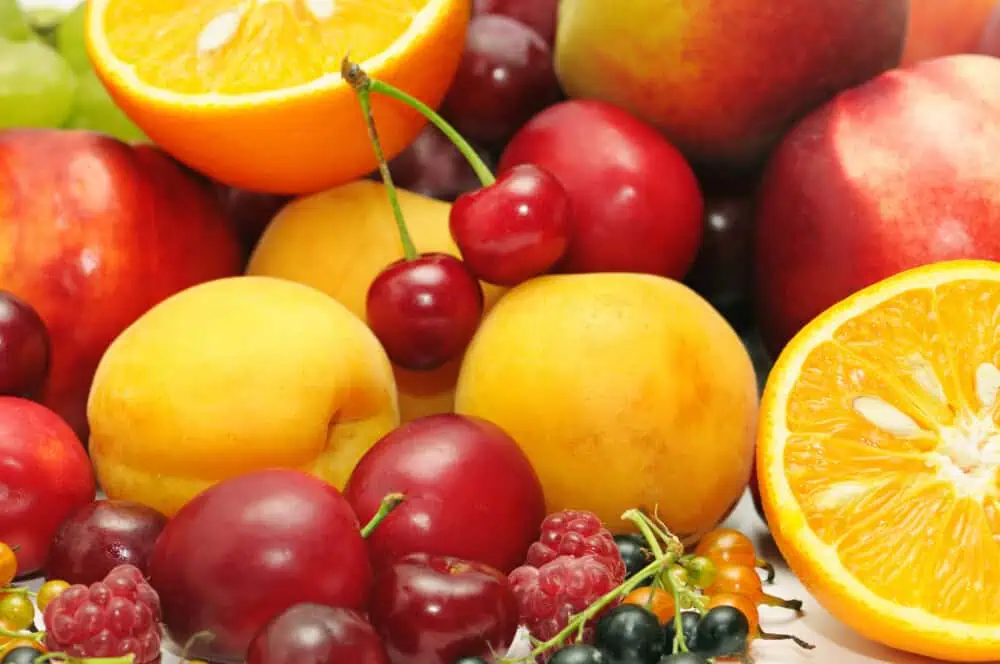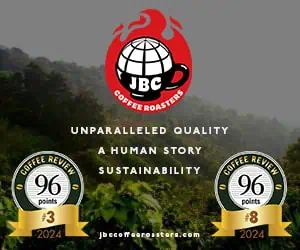
Oranges, peaches, and raspberries are among the natural fruits coffee producers have added to fermentation tanks in recent years to influence the sensory character of green coffees.
The latest controversy to stir up the world of fine coffee is a debate over the legitimacy of creating unique-tasting green coffees by adding natural fruit to the fermentation tank during processing. What’s left of the fruit itself is long gone by the time we experience these coffees, but if the process is successful, complex fruit and sweet sensations may linger in the bean and in the cup, delighting some coffee enthusiasts while outraging others, who find the cup distorted and who consider the process cheating on the rules of fine coffee. These fermented-with-fruit coffees are usually called “fruit infused,” “co-fermented,” or simply “infused.” The #1 coffee on our latest list of Top 30 coffees of 2024 is a 98-rated co-fermented coffee from Hula Daddy Kona Coffee in Hawaii; the Hula Daddy Orange Kahiko was fermented in the whole fruit with oranges produced on the same farm as the coffee. (Only one other co-fermented coffee appears in the Top 30, however, as a component in a two-bean blend.)
The Best of Panama Bomb
The industry-wide debate about the legitimacy of co-fermentation erupted after an Instagram post appeared earlier this year disclosing that four coffees had been disqualified from the prestigious Best of Panama 2024 green coffee competition because they had been “altered from their natural DNA expression, likely with the intent to score higher and win by using foreign additives.” The statement, from J. Hunter Tedman, president of the Specialty Coffee Association of Panama (SCAP) leaves one wondering how this alteration of “natural DNA expression” was confirmed. By gas chromatography? By producer corroboration? By jury consensus? The statement further extends its condemnation to industry use of the processing terms “co-fermented” and “thermal shock,” calling these terms deliberately “deceptive” and intended to “mislead buyers.”
It seems to me that Mr. Tedman needs to fill in some details. Nevertheless, the SCAP’s action appears to have aroused a latent disquiet in the specialty coffee community regarding the legitimacy of recently popularized, unorthodox processing practices, like anaerobic fermentation and, particularly, fruit co-fermentation or infusion. When I was visiting Taiwan this past November promoting my latest book, the question I was most frequently asked by both roasters and consumers was what I thought about “infused” coffees (meaning, usually, fruit-infused or co-fermented coffees), and what was Coffee Review going to do about them?
What we do and will do, of course, is taste them and report as honestly as we can on what we’ve tasted. This has always been our MO at Coffee Review. As for ratings, they reflect what we perceive as consensus assumptions in the specialty world about the value of certain sensations generated by coffee. You can find these assumptions sketched out in our article How Coffee Review Works.
When we devote a report to a new, more radical style of coffee, we typically share our process of determining value for that style with our readers. When the “new naturals” began to arrive on the scene in 2004 and thereafter, we did not simply dismiss them as “tainted” owing to their difference from traditional washed coffees but made distinctions between, for example, those that expressed a cleanly lush fruit and those that expressed a composty fruit. Similarly, in our March 2023 report on anaerobic-processed coffees, our approach was to report positively on versions of the anaerobic style that were balanced and relatively coherent, versions in which the floral and fruit notes were contexted into something generally recognizable as coffee, and in which sweetness came across as natural rather than candyish or cloying.
In the case of co-fermented coffees, note that the fruit is added as an integral part of fermentation, a complex chemical process the details of which are only beginning to be understood. In other words, successful co-fermented coffees are not the result of a simple additive process. They don’t take already processed coffee and add already processed fruit to it. The fresh fruit and fresh coffee react together to create a unique chemical event. Certainly, this explains the complexity of the fruit sensations that emerge in surprising and unpredictable ways in these coffees, as happened with this year’s top coffee, the 98-point Hula Daddy Orange Kahiko.
Coherent Excellence or Cute Tricks?
Nevertheless, to quote from our November 2023 report on fruit- and spice-fermented coffees:
… those outside the specialty coffee tradition probably can’t grasp how ambivalent one can feel in respect to co-fermented coffees. We may support creativity and excitement, but for many of us, the notion of altering the basic taste profile of coffee, sometimes rather radically, by combining coffee with other non-coffee stuff is disturbing, even when accomplished with subtlety. Are we considering the excellence of coffee production from tree to bean as a coherent act of tradition and passion, or are we simply celebrating cute tricks at the end of that process?
The answer to that question needs to come from the industry itself and its most loyal and thoughtful consumers. We at Coffee Review can only keep listening, tasting and communicating with clarity and honesty.











